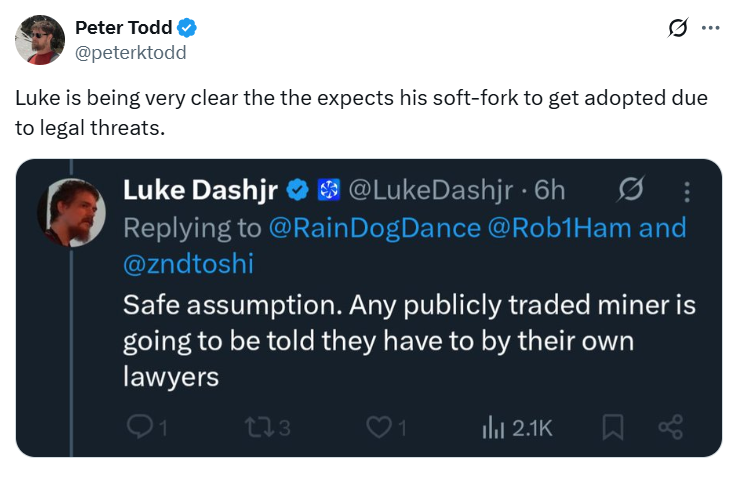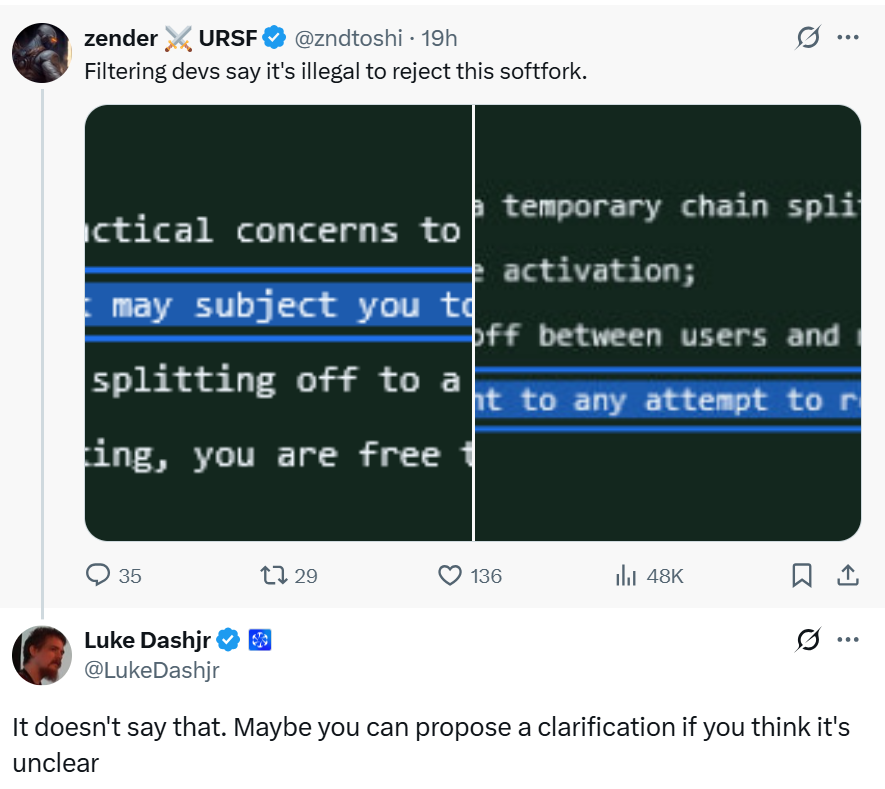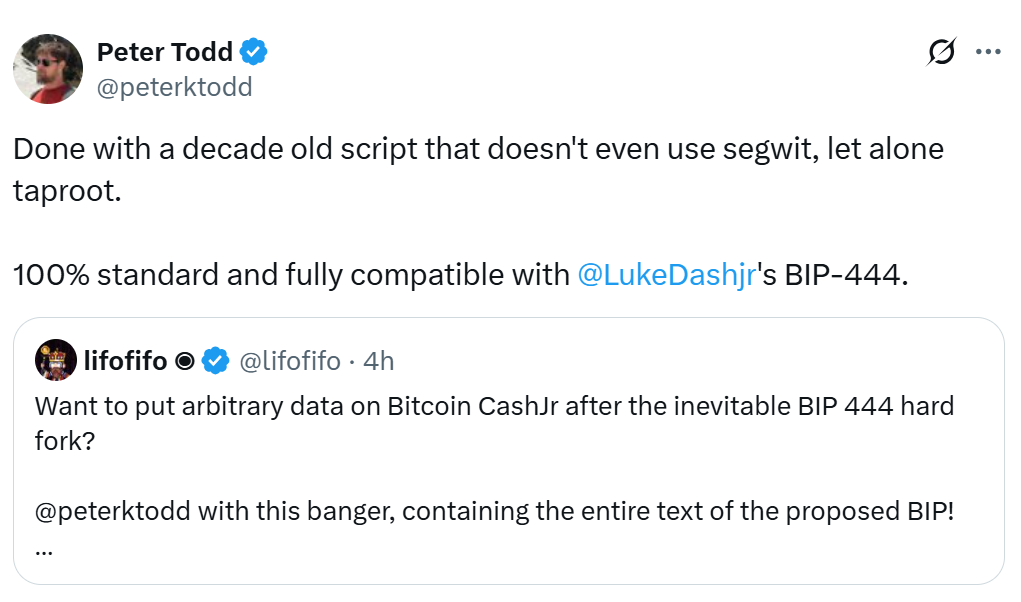The new Bitcoin soft fork proposal by developer Luke Dashjr aims to filter non-financial transactions over one year, but its language warning of moral and legal consequences for rejection has ignited controversy among the Bitcoin community, raising fears of censorship and network splits.
-
Proposal Overview: Introduces a temporary soft fork to restrict illicit data embedding in Bitcoin transactions post-Core v30 update.
-
Controversy Focus: Specific wording on lines 261 and 270-272 suggests legal or moral repercussions for non-adoption, seen by critics as coercive.
-
Community Reaction: Experts like Peter Todd and Alex Thorn label it an attack on Bitcoin’s permissionless nature, with potential for chain splits if unaddressed.
Discover the Bitcoin soft fork proposal controversy: Luke Dashjr’s BIP sparks debate on censorship and legal threats. Explore implications for BTC’s future. Stay informed on crypto updates.
What is the Bitcoin Soft Fork Proposal Controversy?
The Bitcoin soft fork proposal controversy centers on a new improvement proposal (BIP) drafted by core developer Luke Dashjr, which calls for a one-year soft fork to address transaction filtering amid ongoing debates in the Bitcoin Core versus Knots community. This measure seeks to limit non-financial data in transactions while developers finalize a permanent solution, responding to risks of illegal content embedding after the Bitcoin Core v30 update. The uproar stems from provocative language in the proposal that appears to warn against rejection, potentially undermining Bitcoin’s decentralized ethos.
Why Does the Proposal’s Language Spark Outrage?
The Bitcoin soft fork proposal’s language has drawn sharp criticism for implying legal and moral barriers to rejection. On line 261, it states there is a “moral and legal impediment to any attempt to reject this soft fork,” while lines 270-272 elaborate that such rejection “may subject you to legal or moral consequences, or could result in you splitting off to a new altcoin like Bcash.” This phrasing, according to community feedback on platforms like X, evokes authoritarian overtones and contradicts Bitcoin’s founding principles of permissionless innovation and resistance to censorship.
Bitcoin, launched in 2009 as a peer-to-peer electronic cash system, has always prioritized user sovereignty. The proposal emerges from tensions over whether the network should filter out non-financial uses, such as embedding data that could include illegal materials like child sexual abuse material (CSAM). Supporters argue this protects participants from liability, but detractors, including systems engineer Bam, describe it as “Orwellian,” referencing George Orwell’s dystopian novel 1984 where surveillance and control dominate society.
Software engineer Ben Kaufman echoed this, calling a fork under legal threats “the most clear case of an attack on Bitcoin.” Cryptographer Peter Todd shared a screenshot of Dashjr’s comments, noting it signals expectations of adoption through intimidation. Alex Thorn from Galaxy Digital agreed, deeming it “explicitly an attack on Bitcoin” and “incredibly stupid,” highlighting risks of a chain split if miners and users diverge. BitMEX Research further warns that malicious actors could exploit larger data payloads in v30 for double-spend attacks by embedding unlawful content, creating economic incentives for such behavior.

Several lines in a new Bitcoin improvement proposal are being criticized as an attack on the blockchain. Source: GitHub
These reactions underscore a broader debate: Should Bitcoin enforce content moderation to mitigate real-world legal risks, or does this erode its core value as an uncensorable ledger? Data from blockchain analytics shows a rise in non-standard transactions post-v30, with over 15% of recent blocks containing embedded data, per on-chain metrics from sources like Glassnode.
Frequently Asked Questions
What Does the Bitcoin Soft Fork Proposal Aim to Achieve?
The Bitcoin soft fork proposal seeks to implement temporary restrictions on transaction data sizes for one year, filtering out potential non-financial or illicit content while the community develops a long-term fix. This addresses vulnerabilities exposed by the Bitcoin Core v30 update, which expanded data payloads and raised concerns about criminal liability for network participants. Experts emphasize it maintains consensus rules without hard forks.
Is the Bitcoin Soft Fork Proposal’s Language a Legal Threat?
The proposal’s wording about moral and legal impediments to rejection is interpreted variably; critics like Peter Todd see it as coercive, while author Luke Dashjr clarifies it references potential liabilities from unfiltered illicit content on the chain. It does not impose direct penalties but highlights risks, such as those from embedding illegal materials that could implicate users or nodes in jurisdictions with strict laws. Adoption remains voluntary, though community pressure may influence outcomes.
Key Takeaways
- Content Filtering Debate: The proposal targets non-financial data to prevent illegal embeddings, balancing security with Bitcoin’s permissionless design amid post-v30 risks.
- Community Backlash: Influential voices like Alex Thorn and Ben Kaufman view the legal warning language as an assault on decentralization, potentially leading to network fragmentation.
- Technical Feasibility: Despite no major objections, exploits like Peter Todd’s full-text transaction demo suggest the soft fork may not fully resolve data embedding issues—monitor developments for user actions.
Conclusion
The Bitcoin soft fork proposal controversy highlights ongoing tensions between enhancing network security through transaction filtering and preserving the cryptocurrency’s uncensorable foundation. As developers like Luke Dashjr push for measured changes via the one-year soft fork, voices such as Peter Todd warn of broader implications for adoption and chain integrity. With Bitcoin’s market cap exceeding $1 trillion in 2025, stakeholders must navigate this debate carefully to avoid splits. Investors and users should track community discussions on platforms like X and GitHub for updates, ensuring informed participation in Bitcoin’s evolving governance.

Source: Peter Todd

Source: Luke Dashjr

Source: Peter Todd
